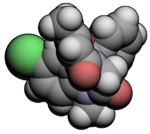Ketazolam
Ketazolam (marketed under the brand names Anseren, Ansieten, Ansietil, Marcen, Sedatival, Sedotime, Solatran and Unakalm) is a drug which is a benzodiazepine derivative. It possesses anxiolytic, anticonvulsant, sedative and skeletal muscle relaxant properties.
 | |
 | |
| Clinical data | |
|---|---|
| AHFS/Drugs.com | Micromedex Detailed Consumer Information |
| Routes of administration | Oral |
| ATC code | |
| Legal status | |
| Legal status |
|
| Pharmacokinetic data | |
| Metabolism | Hepatic |
| Elimination half-life | 26–200 hours |
| Excretion | Renal |
| Identifiers | |
IUPAC name
| |
| CAS Number | |
| PubChem CID | |
| DrugBank | |
| ChemSpider | |
| UNII | |
| KEGG | |
| ECHA InfoCard | 100.043.937 |
| Chemical and physical data | |
| Formula | C20H17ClN2O3 |
| Molar mass | 368.8 g·mol−1 |
| 3D model (JSmol) | |
SMILES
| |
InChI
| |
| (verify) | |
Therapeutic uses
It is used for the treatment of anxiety and has similar effectiveness compared to diazepam. Ketazolam also appears to produce a reduced level of side effects such as sedation compared with diazepam and the side effects when they occur tend to be milder.[2][3][4][5] Ketazolam is also an effective antispasmodic drug and is used for the treatment of spasticity.[6][7][8]
Availability
Ketazolam is not approved for sale in Australia, United Kingdom or the United States.[9] In South Africa, GlaxoSmithKline markets ketazolam under its Solatran brand name.[10] In Canada, ketazolam is listed in schedule IV of the Controlled Drugs and Substances Act, along with other benzodiazepines.[11]
Tolerance and physical dependence
Chronic use of ketazolam as with other benzodiazepines can lead to physical dependence and the appearance of the benzodiazepine withdrawal syndrome upon cessation of use or decrease in dose. Tolerance to ketazolam's therapeutic effects occurs over a period of 15 days.[12]
Contraindications and special caution
Benzodiazepines require special precaution if used in the elderly, during pregnancy, in children, alcohol or drug-dependent individuals and individuals with comorbid psychiatric disorders.[13]
Pharmacokinetics
Ketazolam breaks down in the blood to diazepam which breaks down to demoxepam which breaks down to desmethyldiazepam.[14]
Warnings
The U.S. Food and Drug Administration warns that in Spain, ketazolam marketed as Marcen may sometimes be mistakenly confused with Narcan.[15]
Legal status
Ketazolam is a List 3 drug under the Betäubungsmittelgesetz, like almost all benzodiazepines in Germany. Ketazolam is a List II drugs of the Opium Law in the Netherlands. Ketazolam is a Schedule IV drug under the Controlled Substances Act in the US.[16]
References
- Vega D; Fernández D; Echeverría G (July 2001). "Ketazolam". Acta Crystallogr C. 57 (Pt 7): 848–50. doi:10.1107/S0108270101006175. PMID 11443263.
- Anhalt HS; Young R; Roginsky M (November 1980). "Double-blind comparison of ketazolam, diazepam and placebo in once-a-day vs t.i.d. dosing". The Journal of Clinical Psychiatry. 41 (11): 386–92. PMID 6108319.
- Kim KK; Sirman A; Trainor FS; Lee BY (1980). "Anxiolytic efficacy and safety of ketazolam compared with diazepam and placebo". Clin Ther. 3 (1): 9–14. PMID 6105920.
- Fabre LF Jr; Harris RT (1976). "Double-blind placebo-controlled efficacy study of ketazolam (U-28,774)". J Int Med Res. 4 (1): 50–4. PMID 16791.
- Rickels K; Csanalosi I; Greisman P; Mirman MJ; Morris RJ; Weise CC; Weiss G (October 1980). "Ketazolam and diazepam in anxiety: a controlled study". J Clin Pharmacol. 20 (10): 581–9. doi:10.1002/j.1552-4604.1980.tb01673.x. PMID 6108335.
- Basmajian JV; Shankardass K; Russell D (August 1986). "Ketazolam once daily for spasticity: double-blind cross-over study". Arch Phys Med Rehabil. 67 (8): 556–7. PMID 2874780.
- Katz RT (June 1988). "Management of spasticity". Am J Phys Med Rehabil. 67 (3): 108–16. doi:10.1097/00002060-198806000-00004. PMID 3288246.
- Basmajian JV; Shankardass K; Russell D; Yucel V (November 1984). "Ketazolam treatment for spasticity: double-blind study of a new drug". Arch Phys Med Rehabil. 65 (11): 698–701. PMID 6149738.
- "Benzodiazepine Names". The Tranquilliser Recovery and Awareness Place. Archived from the original on 8 December 2008. Retrieved 26 August 2008.
- "SOLATRAN 15 (capsules) - SOLATRAN 30 (capsules)". South African Electronic Package Inserts. 12 November 1985. Retrieved 26 August 2008.
- http://laws-lois.justice.gc.ca/eng/acts/C-38.8/page-26.html#h-29 Archived 2013-12-15 at the Wayback Machine
- Higgitt A; Fonagy P; Lader M (1988). "The natural history of tolerance to the benzodiazepines". Psychol Med Monogr Suppl. 13: 1–55. doi:10.1017/S0264180100000412. PMID 2908516.
- Authier, N.; Balayssac, D.; Sautereau, M.; Zangarelli, A.; Courty, P.; Somogyi, AA.; Vennat, B.; Llorca, PM.; Eschalier, A. (Nov 2009). "Benzodiazepine dependence: focus on withdrawal syndrome". Ann Pharm Fr. 67 (6): 408–13. doi:10.1016/j.pharma.2009.07.001. PMID 19900604.
- Joyce JR, Bal TS, Ardrey RE, Stevens HM, Moffat AC (June 1984). "The decomposition of benzodiazepines during analysis by capillary gas chromatography/mass spectrometry". Biomed Mass Spectrom. 11 (6): 284–9. doi:10.1002/bms.1200110607. PMID 6743768.
- Food and Drug Administration (January 2006). "FDA Public Health Advisory - Consumers Filling U.S. Prescriptions Abroad May Get the Wrong Active Ingredient Because of Confusing Drug Names". FDA (USA). Archived from the original on 12 August 2006. Retrieved 26 August 2006.
- Drug Enforcement Administration (USA). "Drug Scheduling". United States Government. Retrieved 26 August 2008.